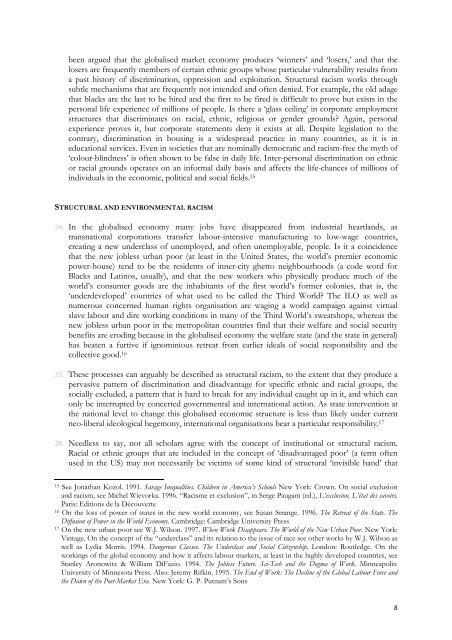112 - Structural Racism and Trends in the Global ... - The ICHRP
112 - Structural Racism and Trends in the Global ... - The ICHRP
112 - Structural Racism and Trends in the Global ... - The ICHRP
Create successful ePaper yourself
Turn your PDF publications into a flip-book with our unique Google optimized e-Paper software.
een argued that <strong>the</strong> globalised market economy produces ‘w<strong>in</strong>ners’ <strong>and</strong> ‘losers,’ <strong>and</strong> that <strong>the</strong><br />
losers are frequently members of certa<strong>in</strong> ethnic groups whose particular vulnerability results from<br />
a past history of discrim<strong>in</strong>ation, oppression <strong>and</strong> exploitation. <strong>Structural</strong> racism works through<br />
subtle mechanisms that are frequently not <strong>in</strong>tended <strong>and</strong> often denied. For example, <strong>the</strong> old adage<br />
that blacks are <strong>the</strong> last to be hired <strong>and</strong> <strong>the</strong> first to be fired is difficult to prove but exists <strong>in</strong> <strong>the</strong><br />
personal life experience of millions of people. Is <strong>the</strong>re a ‘glass ceil<strong>in</strong>g’ <strong>in</strong> corporate employment<br />
structures that discrim<strong>in</strong>ates on racial, ethnic, religious or gender grounds? Aga<strong>in</strong>, personal<br />
experience proves it, but corporate statements deny it exists at all. Despite legislation to <strong>the</strong><br />
contrary, discrim<strong>in</strong>ation <strong>in</strong> hous<strong>in</strong>g is a widespread practice <strong>in</strong> many countries, as it is <strong>in</strong><br />
educational services. Even <strong>in</strong> societies that are nom<strong>in</strong>ally democratic <strong>and</strong> racism-free <strong>the</strong> myth of<br />
‘colour-bl<strong>in</strong>dness’ is often shown to be false <strong>in</strong> daily life. Inter-personal discrim<strong>in</strong>ation on ethnic<br />
or racial grounds operates on an <strong>in</strong>formal daily basis <strong>and</strong> affects <strong>the</strong> life-chances of millions of<br />
<strong>in</strong>dividuals <strong>in</strong> <strong>the</strong> economic, political <strong>and</strong> social fields. 15<br />
STRUCTURAL AND ENVIRONMENTAL RACISM<br />
24. In <strong>the</strong> globalised economy many jobs have disappeared from <strong>in</strong>dustrial heartl<strong>and</strong>s, as<br />
transnational corporations transfer labour-<strong>in</strong>tensive manufactur<strong>in</strong>g to low-wage countries,<br />
creat<strong>in</strong>g a new underclass of unemployed, <strong>and</strong> often unemployable, people. Is it a co<strong>in</strong>cidence<br />
that <strong>the</strong> new jobless urban poor (at least <strong>in</strong> <strong>the</strong> United States, <strong>the</strong> world’s premier economic<br />
power-house) tend to be <strong>the</strong> residents of <strong>in</strong>ner-city ghetto neighbourhoods (a code word for<br />
Blacks <strong>and</strong> Lat<strong>in</strong>os, usually), <strong>and</strong> that <strong>the</strong> new workers who physically produce much of <strong>the</strong><br />
world’s consumer goods are <strong>the</strong> <strong>in</strong>habitants of <strong>the</strong> first world’s former colonies, that is, <strong>the</strong><br />
‘underdeveloped’ countries of what used to be called <strong>the</strong> Third World? <strong>The</strong> ILO as well as<br />
numerous concerned human rights organisation are wag<strong>in</strong>g a world campaign aga<strong>in</strong>st virtual<br />
slave labour <strong>and</strong> dire work<strong>in</strong>g conditions <strong>in</strong> many of <strong>the</strong> Third World’s sweatshops, whereas <strong>the</strong><br />
new jobless urban poor <strong>in</strong> <strong>the</strong> metropolitan countries f<strong>in</strong>d that <strong>the</strong>ir welfare <strong>and</strong> social security<br />
benefits are erod<strong>in</strong>g because <strong>in</strong> <strong>the</strong> globalised economy <strong>the</strong> welfare state (<strong>and</strong> <strong>the</strong> state <strong>in</strong> general)<br />
has beaten a furtive if ignom<strong>in</strong>ious retreat from earlier ideals of social responsibility <strong>and</strong> <strong>the</strong><br />
collective good. 16<br />
25. <strong>The</strong>se processes can arguably be described as structural racism, to <strong>the</strong> extent that <strong>the</strong>y produce a<br />
pervasive pattern of discrim<strong>in</strong>ation <strong>and</strong> disadvantage for specific ethnic <strong>and</strong> racial groups, <strong>the</strong><br />
socially excluded, a pattern that is hard to break for any <strong>in</strong>dividual caught up <strong>in</strong> it, <strong>and</strong> which can<br />
only be <strong>in</strong>terrupted by concerted governmental <strong>and</strong> <strong>in</strong>ternational action. As state <strong>in</strong>tervention at<br />
<strong>the</strong> national level to change this globalised economic structure is less than likely under current<br />
neo-liberal ideological hegemony, <strong>in</strong>ternational organisations bear a particular responsibility. 17<br />
26. Needless to say, not all scholars agree with <strong>the</strong> concept of <strong>in</strong>stitutional or structural racism.<br />
Racial or ethnic groups that are <strong>in</strong>cluded <strong>in</strong> <strong>the</strong> concept of ‘disadvantaged poor’ (a term often<br />
used <strong>in</strong> <strong>the</strong> US) may not necessarily be victims of some k<strong>in</strong>d of structural ‘<strong>in</strong>visible h<strong>and</strong>’ that<br />
15 See Jonathan Kozol. 1991. Savage Inequalities. Children <strong>in</strong> America’s Schools New York: Crown. On social exclusion<br />
<strong>and</strong> racism, see Michel Wievorka. 1996. “<strong>Racism</strong>e et exclusion”, <strong>in</strong> Serge Paugam (ed.), L’exclusion. L’état des savoirs.<br />
Paris: Editions de la Découverte<br />
16 On <strong>the</strong> loss of power of states <strong>in</strong> <strong>the</strong> new world economy, see Susan Strange. 1996. <strong>The</strong> Retreat of <strong>the</strong> State. <strong>The</strong><br />
Diffusion of Power <strong>in</strong> <strong>the</strong> World Economy. Cambridge: Cambridge University Press<br />
17 On <strong>the</strong> new urban poor see W.J. Wilson. 1997. When Work Disappears. <strong>The</strong> World of <strong>the</strong> New Urban Poor. New York:<br />
V<strong>in</strong>tage. On <strong>the</strong> concept of <strong>the</strong> “underclass” <strong>and</strong> its relation to <strong>the</strong> issue of race see o<strong>the</strong>r works by W.J. Wilson as<br />
well as Lydia Morris. 1994. Dangerous Classes. <strong>The</strong> Underclass <strong>and</strong> Social Citizenship. London: Routledge. On <strong>the</strong><br />
work<strong>in</strong>gs of <strong>the</strong> global economy <strong>and</strong> how it affects labour markets, at least <strong>in</strong> <strong>the</strong> highly developed countries, see<br />
Stanley Aronowitz & William DiFazio. 1994. <strong>The</strong> Jobless Future. Sci-Tech <strong>and</strong> <strong>the</strong> Dogma of Work. M<strong>in</strong>neapolis:<br />
University of M<strong>in</strong>nesota Press. Also: Jeremy Rifk<strong>in</strong>. 1995. <strong>The</strong> End of Work: <strong>The</strong> Decl<strong>in</strong>e of <strong>the</strong> <strong>Global</strong> Labour Force <strong>and</strong><br />
<strong>the</strong> Dawn of <strong>the</strong> Post-Market Era. New York: G. P. Putnam’s Sons<br />
8
















